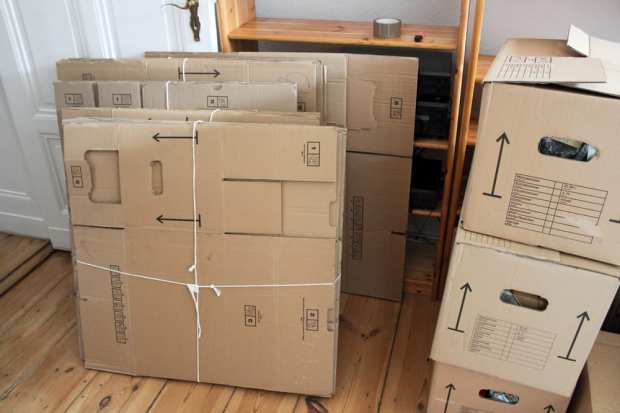Tapping Tech To Take The Misery Out Of Moving

In the annals of digital age start-ups, stories of a business founded in dorm rooms are a dime a dozen. Some stories are more dramatic than others — but they tend to have some common elements: an Ivy League student, a laptop and late-night hours soaked in Red Bull are all common and recurring themes.
So while Bellhops certainly belongs in the pantheon of dorm-founded start-ups — its founding story is undeniably quite different than the rest of the pack. Founders Stephen Vlahos and Cameron Doody weren’t working on changing the world in front of a computer screen in their dorm room — they were moving boxes into other people’s dorm rooms during move-in weekend at Auburn University where they were students in 2011.
The goal, Bellhops CEO Luke Marklin told PYMNTS — had not yet evolved into using digital tools to hit the reset button on the widely loathed $18 billion a year moving industry. Mostly, he said, they were hoping to make maybe a couple of thousand dollars hoofing boxes for a few days.
“They ended up making [$30,000] and found they were 15 times oversubscribed for their moving services. And that experience is what led them to realize the moving industry was home to a lot of opportunities.”
From that core, moving services carried out to polite, friendly college students on a single college campus — Bellhops has grown quite considerably. Today the firm operates in 41 states and uses a digital technology platform to match people with movers in a professional, trustworthy and timely manner.
It is not the experience most consumers are used to, Marklin said, but he believes it is a standard that consumers will soon come to demand.
Rehabilitating A Reviled Industry
If, for some reason, one was trying to custom design a friction-filled miserable customer experience, one would soon find it is hard to succeed better than the majority of the moving industry has by simple inertia. There are a lot of small operations out there, Marklin noted, that are making quite a good living offering the absolute minimum in terms of service. An attitude which has left the sector in something of an innovative dead zone until quite recently. If it’s working — why fix it?
The problem, of course, is that it is not working for consumers, who loathe the industry by and large. And for good reasons, Marklin said. Moving is not only expensive at its base, but the pricing is also usually completely opaque and laden with hidden fees. That means the customer doesn’t know what they will be paying until the final bill is handed to them — though they can be confident it will be much, much higher than whatever price they were quoted. Moreover, it’s not just the price; the customer also doesn’t know who will be showing up on their doorstep on moving day. It might be a college student working a side hustle, but it might not be someone very different from that.
“The ability of the moving industry to hire really good people is limited. Very often you have people showing up whom you might not want in your home handling all of your possessions,” Marklin said.
And that, of course, is if they show up at all. Despite the fact that most moving companies required a 21 day run time to schedule a move — plus an in-home visit to draw up that initial quote that will bear no resemblance to the bill the customer ultimately pays — Bellhops has dealt with all kinds of consumers reaching out in a panic because the moving company they’ve spent a month coordinating with has suddenly ghosted them 24 hours before they are supposed to move.
“We’re not fully on-demand. Most of our moves come with a standard run time for moving of a couple of weeks. But when people get themselves in a situation when they need help or last-minute support — we can do that too. We’re very flexible and we are more than happy to come through when other movers fail.”
Moreover, Marklin noted, that strategy — take the broken issue and flip it on its head — has been the guiding idea in how Bellhops has used its two-sided platform. Moving, he noted is viewed as a chore when it should be considered to be a happy experience. Their platform, he said, works on three levers: people, process and price to deliver the better move for customers.
The customer doesn’t need to endure a lengthy back-and-forth over the phone or a home visit to schedule a move — they go online or on mobile, enter a date and some basic information about their move and book it like an Uber ride. They don’t have to worry who is showing up because the movers are vetted before joining the platform and reviewed after each job. So the customer knows who they are, what their background is and how many moves they have under their belt. The price, he said, is the price they are quoted. There are no extra “irregularly shaped” box fees that jump up to bite customers.
A Bellhops For Every Job
The trouble with running a moving company — even an innovative one — is that no matter how good a job one does, the assumption is there will only be so much repeat business. No matter how delightful the experience, after all, people only move but so often in their lifetimes.
Or at least that is what one might assume — though Marklin said their data tells a slightly different story.
First, he noted, people move more often as of 2019 than they ever have before. The idea of packing up the cats and trucking out to the suburbs and staying there for three-decades is a bit out of date — and out of step with the life paths of many millennials.
They do see a fair amount of repeat business, he noted, as they are seeing more and more customers moving every 24 or so months.
Also, he said, moving services are more useful than merely having someone show up on moving day. The fact that movers do not regularly show up in more context than just packing households into trust, he noted, is more a testament to how no one hires a moving company unless they have to.
“We didn’t call ourselves Bellhops moving. We are Bellhops — and we can help in a variety of circumstances. We see a lot of customers who use us for a move. And then a few months later, they need help rearranging things, or removing things — and we’re excellent at that. We provide moving services to the home and we provide moving services in the home. There are probably a lot more uses for movers than you’d think.”
And what they’ve seen so far is that when hiring a mover is a smooth experience, instead of an onerous chore — people are a lot more open to exploring all of those other uses.
